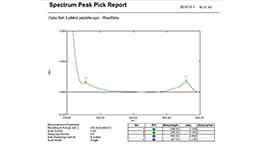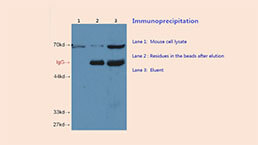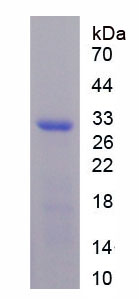Eukaryotic Growth Differentiation Factor 15 (GDF15)
PDF; MIC1; NAG-1; PLAB; PTGFB; Macrophage inhibitory cytokine 1; NSAID-activated gene 1 protein; Placental bone morphogenetic protein; Prostate differentiation factor
- Product No.EPC034Hu62
- Organism SpeciesHomo sapiens (Human) Same name, Different species.
- SourceEukaryotic expression
- Host293F
- Endotoxin Level<1.0EU per 1µg (determined by the LAL method)
- Subcellular LocationSecreted
- Predicted Molecular Mass25.3kDa
- Accurate Molecular Mass30kDa(Analysis of differences refer to the manual)
- Residues & TagsAla195~Ile308 with Two N-terminal Tags, His-tag and SUMO-tag
- Buffer FormulationPBS, pH7.4, containing 5% Trehalose.
- Traits Freeze-dried powder
- Purity> 95%
- Isoelectric Point7.9
-
Applications
Positive Control; Immunogen; SDS-PAGE; WB.
If bio-activity of the protein is needed, please check active protein. - DownloadInstruction Manual
- UOM 10µg50µg 200µg 1mg 5mg
- FOB
US$ 204
US$ 510
US$ 1020
US$ 3060
US$ 7650
For more details, please contact local distributors!
SEQUENCE

USAGE
Reconstitute in 10mM PBS (pH7.4) to a concentration of 0.1-1.0 mg/mL. Do not vortex.
STORAGE
Avoid repeated freeze/thaw cycles. Store at 2-8°C for one month. Aliquot and store at -80°C for 12 months.
STABILITY
The thermal stability is described by the loss rate. The loss rate was determined by accelerated thermal degradation test, that is, incubate the protein at 37°C for 48h, and no obvious degradation and precipitation were observed. The loss rate is less than 5% within the expiration date under appropriate storage condition.
GIVEAWAYS
INCREMENT SERVICES
-
 BCA Protein Quantification Kit
BCA Protein Quantification Kit
-
 Protein Labeling Customized Service
Protein Labeling Customized Service
-
 Molecular Mass Marker for Protein
Molecular Mass Marker for Protein
-
 Monoclonal Antibody Customized Service
Monoclonal Antibody Customized Service
-
 Polyclonal Antibody Customized Service
Polyclonal Antibody Customized Service
-
 Protein Activity Test Experiment Service
Protein Activity Test Experiment Service
-
 Immunoprecipitation (IP) Experiment Service
Immunoprecipitation (IP) Experiment Service
-
 Electrophoretic Mobility Shift Assay (EMSA) Experiment Service
Electrophoretic Mobility Shift Assay (EMSA) Experiment Service
-
 Buffer
Buffer
-
 Lentivirus Packaging Experiment Service
Lentivirus Packaging Experiment Service
-
 Adenovirus Packaging Experiment Service
Adenovirus Packaging Experiment Service
-
 Real Time PCR Experimental Service
Real Time PCR Experimental Service
-
 Spike RBD Protein (S-RBD)
Spike RBD Protein (S-RBD)
-
 Protein G
Protein G
-
 Protein A
Protein A
| Magazine | Citations |
| Clinical cardiology | Growth Differentiation Factor 15 and Coronary Collateral Formation PubMed: 20014173 |
| Personalized Medicine | Elevated levels of GDF-15 is associated with increased angiotensin II in hypertensive patients with Type 2 diabetes pme-2016-0030 |
| LIFE SCIENCES | Rapamycin improves renal injury induced by Iodixanol in diabetic rats by deactivating the mTOR/p70S6K signaling pathway Pubmed: 32798557 |
| Microbiome changes in patients with chronic heart failure with preserved ejection fraction correlate with fibrosis markers: Description of a Russian cohort | |
| SEMINARS IN DIALYSIS | Serum NT©\proBNP levels are associated with cognitive functions in hemodialysis patients 33423325 |
| Taiwanese Journal of Obstetrics & Gynecology | Is GDF-15 level associated with gestational diabetes mellitus and adverse perinatal outcomes? 33678319 |
| J Inflamm Res | Changes in Plasma Growth Differentiation Factor-15 After Laparoscopic Sleeve Gastrectomy in Morbidly Obese Patients: A Prospective Study 33880052 |
| Russian Journal of Cardiology | Predictive value of growth differentiation factor-15 in patients with myocardial infarction |
| Nutrients | High Fat, High Sugar Diet and DJOS Bariatric Surgery Influence Plasma Levels of Fetuin-B, Growth Differentiation Factor-15, and Pentraxin 3 in Diet-Induced Obese … 34684637 |
| Nat Metab | Small extracellular vesicle-mediated targeting of hypothalamic AMPKα1 corrects obesity through BAT activation 34675439 |
| Acta Cardiol Sin | Growth Differentiation Factor 15 is Related with Left Ventricular Recovery in Patients with ST-Elevation Myocardial Infarction after Successful Reperfusion by … 34584380 |
| Surgical Endoscopy | The effect of bariatric surgery on the expression of Growth Differentiation Factor-15/Macrophage-Inhibitory Cytokine-1 (GDF-15/MIC-1) in rat Pubmed:35029766 |
| Journal of Clinical Laboratory Analysis | Plasma growth differentiation factor‐15 in patients with “lone” atrial fibrillation Pubmed:35334497 |








